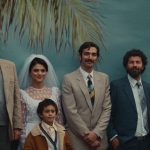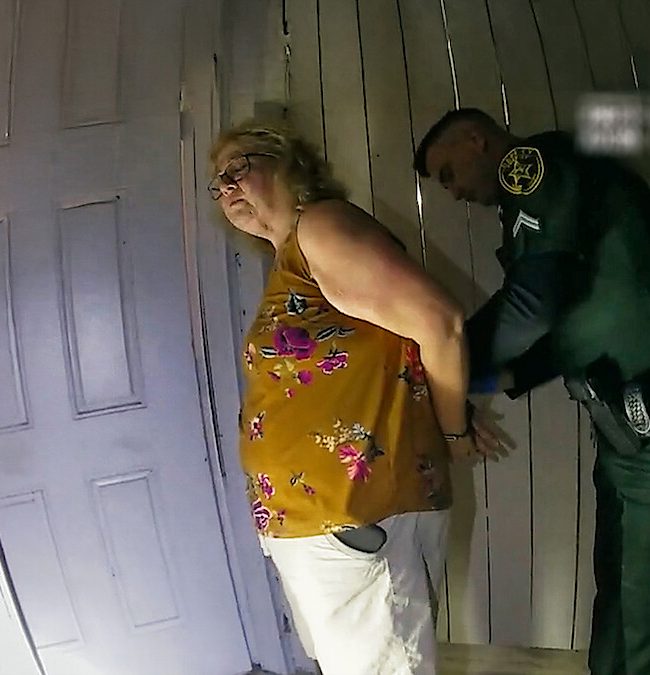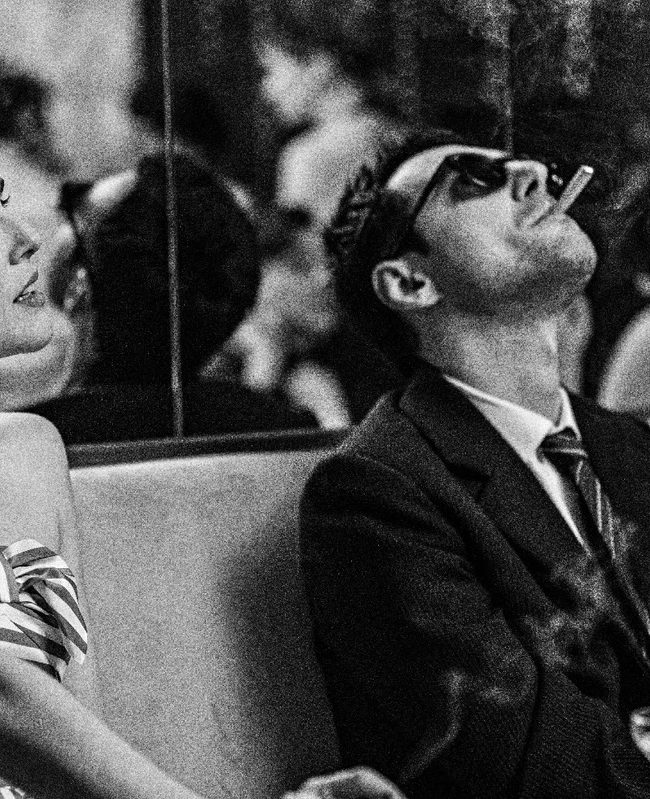A Conversation with José Rubén Escalante (CONTRAATAQUE/COUNTERATTACK)

I recently enjoyed a Zoom conversation with J.R. Escalante, the screenwriter for the new film from Mexico, Contraataque (Counterattack). It premiered on Netflix on March 4th and within just a few weeks had achieved 58 million views. Stewart Clarke recently reported on Deadline that the film had now reached 71 million views and was in the “global all-time Top 10 for non-English-language films” on Netflix.
Hammer to Nail: Please describe the plot and themes of Contraataque.
J.R. Escalante: Five soldiers, who are in the Murciélagos, an elite Special Forces unit of the Mexican army, are driving to the US border to celebrate the birthday of the youngest soldier on their team. On the highway they are attacked by some sicarios (hired killers) from El Enjambre drug cartel. They defeat that group, but since their car has been destroyed and they learn that more members of the cartel will shortly come after them, they escape into the hills and prepare for an unavoidable showdown. Even though they are outnumbered and you think that they’re gonna lose, they end up defeating the cartel at great cost. So, the main theme of the movie is heroism and the good guys winning because in Mexican films the good guys never win.
HtN: I’ve read that Hitchcock said that the seed for many of his films started with an image. Like for Vertigo, he imagined a woman in a fog-enshrouded cemetery. Did you have any image or situation in mind before you even started writing?
JRE: Yeah, actually I did. The image was of a burial pit by a highway, because it’s, sadly enough, a very typical thing here in Mexico. Drug dealers murder a lot of people and throw their corpses into shallow pits. With that image in my head, I thought it’s an interesting starting point for an inciting incident.
HtN: The fact that there’s even a word for a cartel’s burial pit, narcofosa, is very distressing, of course.
JRE: Oh, of course.
HtN: Three of your scripts had already been turned into feature films, so you knew your way around the film industry in Mexico. Talk a little bit about De las muertas (2018), Un día salvaje (completed in 2020), and La marca del demonio (2020).
JRE: De las muertas was actually my first script. When I wrote it, I also hoped to direct the project, and I started pitching it around. I got very close to developing it. I was very young at the time, I was like 24, 25. Eventually it didn’t happen, so I got a little bit frustrated and started working on other things. A few years later I met some producers and we talked about writing. They said, “Do you have any samples we can read?” I gave them De las muertas. A couple of weeks later they called me and said that they found a director that wanted to direct the movie. I was very surprised and emotional when it happened.
We have a saying here in Mexico that when you’re having a baby, the kid brings a cake with him – “Cada niño nace con un pastel bajo el brazo.” My wife Tanya said that to me when we were expecting Julián, our first one, right around the time that we made De las muertas, so it was kind of like a blessing.
The movie’s a thriller. It’s about all the violence against women here in Mexico. It’s a very, very harsh film. You can find it on Amazon Prime.
The basic premise of Un dia salvaje (One Wild Day) is that an undercover cop brings down a group of corrupt cops and becomes a hero. The difference between the movie and my screenplay is that they completely changed my written work. I was very upset about that. I wanted to make an action movie where the good guys win, but the producers didn’t respect that. They made the bad guys win. It stuck in my brain and that’s the idea where Counterattack started coming from.
HtN: Which makes the title even more significant. It’s your counter-attack on those producers.
JRE: The third movie, La marca del demonio (The Mark of the Demon) started as a very ambitious screenplay about a Mennonite exorcist. It’s an interesting thing mixing religion with exorcism. But once again, the production company who made it didn’t respect my screenplay. I’m only proud of the fact that it became a little bit successful when it came out in theaters. On Netflix it stayed in the top 10 foreign language films for two weeks.
HtN: How did you go about finding a producer for Counterattack?
JRE: I was already working with a producer, Francisco González Compeán, and his production company Draco Films. I was working with them on another project for a TV show. Funny enough we were having a writer’s room meeting when we were talking about some scenes. I told them that we have to try to break new ground in Mexico because we never make a film or a TV series where the good guys win. I described my idea about some soldiers winning a gun fight on a highway. The producer asked me to go on, so I described some more scenes. He said, “If you want to make that film, I will make it with you.” From the day that I pitched them the idea for Counterattack, it was literally nine months later that we were filming the movie. So, it got together really, really fast, especially considering it’s one of the most expensive movies ever made in Mexico.
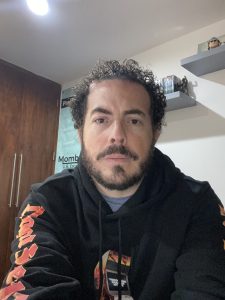
Screenwriter José Rubén Escalante
HtN: So, while you’re writing a treatment even before the script, I think you’ve said in one interview that you’d bounce some ideas off Tanya, your wife, whom I first met 20 or so years ago when she visited Austin. How does that work?
JRE: My wife studied film production and everything. She knows the media. She’s very good at bouncing ideas for me. For example, when I start thinking about an idea, I say it out loud and I can see her reaction. Maybe she’s like, “I like the idea” or “I don’t understand it.” When an idea is very fast and she gets it right away, that’s when I know I have something really good.
HtN: How many versions of the script did you go through?
JRE: When I was writing the first draft, the producer was getting ready to shoot another film. He hired me to read the other screenplay and give him notes because it’s also an action movie. I told him that script really didn’t work. I said, “We can go with Contraataque.” He was like, “Yeah, but you haven’t even written the screenplay yet.” I told him, “Trust me. I’m gonna have the screenplay incredibly fast.”
It took me 12 days or something like that and I sent him the screenplay. I didn’t hear from him for like a month and a half. I was working on something else and didn’t worry too much, but then after a while I began thinking that González Compeán must have decided the script was the worst piece of crap he had ever read. But just 2-3 days after that, he sent me a message on a Sunday on WhatsApp: “I just finished reading your screenplay for the second time in a row. It’s an absolute masterpiece. I love it. And we have to talk tomorrow.”
I went to the meeting with him, and he told me, “I know we said we’re gonna work on the second draft to send to the investors, but I already sent the first draft to them [Videocine].”
That first draft got the green light for the project. I only wrote two more drafts and some additional things. In the end it was about 97 pages long.
The way that I like to work is that the first draft is the one that I take the most time with, because as I’m writing it, it has to build in my mind. A lot of people have told me that when they read my first draft, “It’s like the seventh or eighth draft. This is very advanced, it’s not so raw.”
HtN: The director of Contraataque is Chava Cartas who has been directing films and TV episodes in Mexico for 20 years. The only other film that I’ve seen of his, Nuestros Tiempos (Our Times), is very different from Contraataque. It’s a time-travel film which compares the suffocating sexism of 1966 with greater opportunities for women in 2025. So, how did Cartas get chosen to direct Contraataque?
JRE: Even when I had written only the five-page treatment, the producer sent it to Chava, who wrote back, “This is the movie that I have wanted to make all of my life. Do not give it to anybody else. I’m the director of the film.”
HtN: What was it like working with him?
JRE: It was just amazing. What I wrote, he put on the screen. Two days prior to the production starting, Cartas wrote me a message on Instagram where he said, “Two more days, my brother, so we can tell your story finally.” He’s very respectful of the screenwriter.
HtN: Once pre-production began, was your job done or did you have any other time with them?
JRE: When they started filming, I was already working on a TV series that I wrote. It’s called El Juicio (The Trial). It’s a big show starring Eugenio Derbez and Pedro Alonso and will be on Amazon Prime next year.
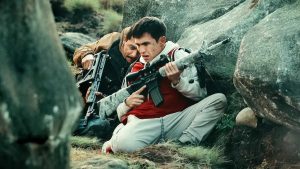
A still from CONTRAATAQUE
So, I was only able to go the first day of filming Contraataque. I told González Compeán, “I want to do the first claqueta [clapper board].” That’s a very rich tradition in Mexico. The producers of my previous three films made fun of that request, but when I asked Francisco, he said “Of course! Do it!”
I talked to the crew and everybody was really emotional. I said, “This is the beginning of something really huge because it’s never been made in Mexico and we know we’re gonna do an amazing job together.”
One of my nephews worked on the production and he was like my eyes on the set. He sent me pictures and videos and I was really excited. I was more involved with post-production.
HtN: Talk about that.
JRE: The producer was very hesitant to show me the first cut of the film. It was two hours and 45 minutes long. And it’s basically the complete screenplay that I wrote. There’s obviously a lot of material that got cut, especially scenes with the soldiers going through the hills. One of the running bits in the screenplay was the Murciélagos captain trying to pep talk the other four exhausted soldiers, “Come on, we can do it, we have to go.” I wrote very specific, very heroic lines. I felt very proud of the lines, but when I saw the rough cut, I said, “Okay, first of all, the pep talk’s gotta go.” I mean, that’s the trial and error, you know. Some things work, some things don’t.
HtN: The film’s setting is Valle Hermoso in northeast Mexico. Was that in your script all the time?
JRE: There are two reasons I chose that setting. The first is that I wanted to write a gag. The name of the city is Ciudad del Valle Hermoso [City of the Beautiful Valley]. One of the soldiers asks, “Captain, why do they call it Ciudad del Valle Hermoso?” Capt. Guerrero says, “They actually call it the City of Three Lies, because it’s not a city, it’s not a valley, and it’s not beautiful.”
The other reason is that the cartel members in that part of the country are horrendously bad. I know the place because I’ve gone on that highway with my wife to cross the border. We passed there many times, and it always stuck in my mind, so I said it was a great place to set the movie.
HtN: On the other hand, all the film’s landscape is beautiful, at least outside of Valle Hermoso. Was that filmed in the state of Tamaulipas?
JRE: No. Because they ended up filming the movie in el estado de México [the state surrounding Mexico City]. The actual Valle Hermoso is like a huge desert. And I told them, “It’s fine. I don’t care if you film in el estado de México, but obviously the people in the state of Tamaulipas are gonna say, “Are you insane?”
Months after the movie came out, I was talking to my wife’s cousin. She told me, “Oh, it’s so beautiful, the way you guys captured Valle Hermoso.” I told her, “What are you talking about? It’s like a huge desert.” And she said, “No, no, no” and started showing me pictures. And there are forests, and there’s hills, and it’s beautiful. I finally understood why nobody from Tamaulipas complained, because they do have that kind of scenery there, so I live and learn, right?
HtN: While they’re not principal characters, there are quite a few women in the film. I love the fact that there are three women soldiers in the Murciélagos. Then there’s Cobra, the really scary woman that’s in the cartel, and then of course the mother and the daughter that are kidnapped. Were they all in your script?
JRE: When I started writing the script, I always had the idea that at the beginning the mother and daughter would discover the burial pit containing the bodies of the soldiers, but I didn’t plan for those women to be in any scenes afterwards. But when I started writing the first draft when the five guys reach the house after the gun battle on the highway and more battles in the forest, I started thinking this is not working. At the end of the day, they’re gonna have to run. I mean, we need something to keep them in that house for the final shootout. And then I realized I could bring back the two women, now kidnapped by the narcos and held captive in that house. It worked beautifully, especially because in the house there would now be five soldiers and two women and they become seven, the “magnificent seven,” all fighting the cartel sicarios.
At heart, Counterattack is a Western. For example, in every Western, the shootout at the end happens at the fort or in a house, or something like that. That’s exactly what happens in Counterattack.
HtN: You depict fear and complicity of the town police in regard to the cartel as well as the corruption of the federal government official. That sets up a perfect contrast with the five heroic soldiers, the Murciélagos. It’s almost like they are the last hope of really combating the narcotraficantes.
JRE: That’s where the quote comes from, the line that appears at the end of the movie – “The only thing necessary for evil to triumph is that good men do nothing.” The producer found that line.
HtN: I love the ending, the three men and the two women on the helicopter and no dialogue. They’re exhausted, they’re bloodstained, they’re sweating, they’ve gone through hell. I was worried that we were going to have a little epilogue with the government official being arrested, and the drug dealer going to prison, all that. I think the silence made a perfect ending. Is that how you envisioned it?
JRE: Yeah, pretty much. They had a throw-away line that they never filmed, something about next they’re going to go get the government official.
I actually had a meeting with people at Netflix a few weeks ago. We were talking about another project and I told them that this is the best ending for a Mexican film in the last 20 years and I’ll stand by that.
It’s very emotional. When you see it in a theater with people, it’s amazing because the theater is always like quiet and everyone’s like, “Oh, my God.” And when the final note comes up and you see the five and you know that the other two died, it always brings down the house.
I did get to watch it in theaters a few times and it was very beautiful. The best one was when I saw it with my boys. When the movie ended, my oldest one was sitting right next to me, and he collapsed in my arms crying.
– Chale Nafus (@chale_nafus)




